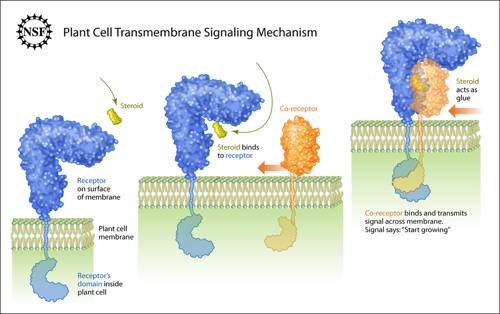
FAQ About Indoor Plant Hormonal Balances

What are plant hormones and why are they important?
Plant hormones, also known as phytohormones, are naturally occurring organic substances that influence physiological processes at low concentrations. They are crucial for regulating growth, development, and responses to environmental stimuli in plants. Five main types of plant hormones include auxins, cytokinins, gibberellins, ethylene, and abscisic acid, each playing specific roles in processes such as cell division, stem elongation, and response to stress.

How can I tell if my indoor plants are experiencing hormonal imbalances?
Hormonal imbalances in indoor plants often manifest through abnormal growth patterns, such as excessive elongation, stunted growth, leaf yellowing, poor flowering, or fruiting anomalies. Observing these symptoms and understanding which hormones impact these characteristics can help diagnose hormonal imbalances and guide appropriate treatment. However, other factors like nutrient deficiency or pest issues may also cause similar symptoms, so it’s essential to conduct a thorough assessment.

What role do auxins play in indoor plant growth?
Auxins are a class of plant hormones that play a vital role in the regulation of plant growth and development. In indoor plants, auxins promote cell elongation and root initiation, contribute to phototropism (growth toward light), and help maintain apical dominance (the inhibition of lateral bud growth). Proper levels of auxins are crucial for healthy plant architecture and robust root systems.

How can I naturally regulate hormonal balances in my indoor plants?
To naturally regulate hormonal balances in indoor plants, ensure they receive adequate light, water, and nutrients. Mimic natural conditions as much as possible by providing proper soil aeration, appropriate temperature, and humidity levels. Organic additives like compost or plant-based biostimulants can support hormone balance by enhancing soil health and microbial activity, which in turn influences hormone production and distribution.

Can I use commercial hormone products to aid indoor plant growth?
Yes, commercial hormone products such as rooting hormones or growth regulators can aid indoor plant growth by supplementing natural hormone levels for specific purposes. For instance, rooting hormones contain synthetic auxins that promote root development in cuttings. However, use these products carefully following the instructions, as overuse or incorrect application can lead to adverse effects such as stunting or deformation.

What is the impact of light on plant hormonal balance?
Light is a critical factor influencing plant hormonal balance, as it affects processes like photosynthesis, hormone synthesis, and circadian rhythms. For example, light influences the distribution of auxins through phototropism, promoting differential growth and directing plants toward light sources. Inadequate or excessive light can disrupt hormone production and lead to unbalanced growth or stress responses.

How do cytokinins affect indoor plant health?
Cytokinins are plant hormones that primarily promote cell division and influence nutrient mobilization. In indoor plants, cytokinins can enhance shoot development, delay leaf senescence, and improve photosynthetic efficiency by maintaining chlorophyll levels. Balanced cytokinin levels contribute to vibrant foliage, though an excess can lead to uncontrolled growth or reduced root development.

Are there natural sources of plant hormones that can be used at home?
Yes, several natural materials can act as sources of plant hormones. For instance, seaweed extract is rich in cytokinins and auxins, and compost teas can provide a range of beneficial microbial interactions that influence hormone activity. Using these organic sources can help maintain hormonal balance and improve overall plant health.

What are gibberellins and their role in plant growth?
Gibberellins are a group of plant hormones that promote stem elongation, seed germination, and flowering. In indoor plants, they can stimulate growth and break dormancy in seeds and buds. Maintaining adequate gibberellin levels is important for achieving desired plant height and ensuring timely germination and flowering, especially in controlled environments such as indoors.

How does ethylene affect indoor plants?
Ethylene is a gaseous plant hormone involved in fruit ripening, flower wilting, and response to stress. In indoor plants, it can be used to accelerate fruit maturation or trigger leaf abscission when needed. However, ethylene sensitivity varies among plant species; excessive exposure can lead to premature aging or unwanted leaf drop, so monitoring its levels is crucial.

What is abscisic acid and what does it do in plants?
Abscisic acid (ABA) is a plant hormone that plays a crucial role in stress response, particularly related to drought and cold conditions. In indoor plants, ABA helps regulate water use by controlling stomatal closure and can induce dormancy indirectly helping survive unfavorable conditions. Keeping ABA in balance is key to managing water stress and ensuring plant endurance in fluctuating indoor environments.

How do humidity levels affect plant hormones?
Humidity levels impact plant hormone activity by influencing stomatal behavior and transpiration rates, which in turn affect internal water status and hormone distribution. For instance, high humidity can slow transpiration, influencing the movement of hormones like abscisic acid within the plant, potentially affecting growth patterns and stress responses. Maintaining appropriate humidity for specific plant species helps sustain hormonal balance and health.

Can pruning influence the hormonal balance in indoor plants?
Yes, pruning can influence hormonal balance by altering the distribution and concentration of auxins and cytokinins within the plant. Removing apical buds reduces auxin dominance, encouraging lateral bud development and achieving bushier growth. This technique is often used to manage shape and promote healthier canopy formation, but pruning should be done thoughtfully to ensure balanced growth.

Is there a link between soil quality and plant hormone levels?
Soil quality has a significant impact on plant hormone levels, as it influences nutrient availability, microbial activity, and root health. Healthy, nutrient-rich soil supports natural hormone production and distribution, enabling optimal growth and resilience. Poor soil conditions can lead to hormonal imbalances, resulting in stunted growth or increased susceptibility to stress and disease.

How do root hormones work in indoor plants?
Root hormones, often containing synthetic auxins, work by stimulating root initiation and growth in plant cuttings or transplants. They promote cell elongation and division at the site of application, aiding successful rooting and establishment. Used correctly, root hormones can enhance propagation success rates and establish strong root systems, critical for healthy indoor plant growth.

What common mistakes can disrupt hormonal balance in indoor plants?
Common mistakes include over-fertilization, inadequate light exposure, improper watering, and poor soil conditions. These factors can stress plants, disrupting hormone synthesis and distribution. For example, excessive nitrogen can lead to reduced flowering due to hormone imbalances, while inadequate light can hinder auxin and cytokinin balance, affecting growth and health. It is vital to maintain a balanced care routine tailored to each plant's needs.

Can stress influence the hormonal balance in indoor plants?
Yes, stress from environmental factors such as drought, pests, or extreme temperatures can significantly affect hormonal balance. Plants may produce more abscisic acid under drought conditions to reduce water loss or increase ethylene levels during pest attacks to signal defense mechanisms. Managing stressors through proper care helps maintain hormonal equilibrium and improve plant resilience.

How can temperature fluctuations affect hormonal balances in indoor plants?
Temperature fluctuations can significantly impact plant hormone activity. For indoor plants, abrupt changes can disrupt processes like flower induction, seed germination, and stress responses. For example, low temperatures might slow the production of gibberellins, affecting growth and bud development, while high temperatures can increase respiration rates, potentially offsetting hormonal balances critical for sustaining growth.

Why is it important to understand the balance of plant hormones?
Understanding the balance of plant hormones is crucial for fostering healthy plant growth and addressing challenges like poor development, stress, or diseases. Proper hormonal balance ensures indoor plants grow in an optimal manner, displaying vibrant foliage, robust roots, and appropriate responses to environmental stimuli. This knowledge aids in devising effective care and intervention strategies.
